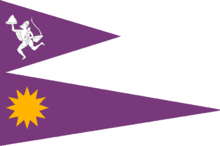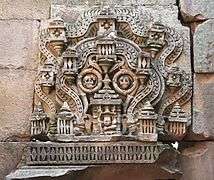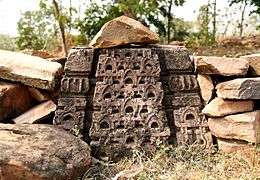Ajaigarh
Ajaigarh or Adjygurh (Hindi: अजैगढ) is a town and a nagar panchayat in the Panna District of Madhya Pradesh state in central India.
History

Ajaigarh was the capital of a princely state of the same name during the British Raj. Ajaigarh was founded in 1765 by Guman Singh, a bundela Rajput who was the nephew of Raja Pahar Singh of Jaitpur. After Ajaigarh was captured by the British in 1809, it became a princely state in the Bundelkhand Agency of the Central India Agency. It had an area of 771 square miles (2,000 km2), and a population of 78,236 in 1901. The rulers bore the title of sawai maharaja. He commanded an estimated annual revenue of about £15,000/-, and paid a tribute of £460/-. The chief resided at the town of Nowgong, at the foot of the hill-fortress of Ajaigarh, from which the state took its name. This fort, situated on a steep hill, towers more than 800 ft (244 m) above the eponymous township, and contains the ruins of several temples adorned with elaborately carved sculptures. The town was often afflicted by malaria, and suffered severely from famine in 1868–1869 and 1896–1897.
The state acceded to the Government of India on January 1, 1950; the ruling chief was granted a privy purse of Rs. 74,700/-, and the courtesy use of his styles and titles. All of these were revoked by the government of India in 1971, at the time when these privileges were revoked from all erstwhile princes. The former princely state became part of the new Indian state of Vindhya Pradesh, and most of the territory of the former state, including the town of Ajaigarh, became part of Panna District, with a smaller portion going to Chhatarpur District. Vindhya Pradesh was merged into Madhya Pradesh on November 1, 1956.

Rulers Of Ajaygarh
Maharajadhiraja Chhatrasal : 1649–1731 (founder ruler of many kingdoms) ___________________________|______________________________ Hirdeshah Jagatraj Bhartichandra (Panna) (Jaitpur) (Jaso) ____________________________|______________________________ Vir Singh Kirat Singh Pahar Singh (1758–1765) ____________________________|______________________________ Khuman Singh Guman Singh (1765–1792) Durg Singh (Charkari) (Banda)(No issues) | |__________________Son of______| Bhakhat Singh :b. 1792-d. 1837 (Founder ruler of Ajaigarh) _____________________________|_______________________________ Madho Singh (r. 1837-1849) Mahipat Singh (r. 1849–1853) (No male issue) | | Ranjore Singh (K.C.I.E)__________Vijay Singh (R. 1853–1855) (born 1844; died 1919) (died early, fell from horse) | Punyapratap Singh: born 1884; died 1958
| Devendra Vijay Singh :born 1913-died 1984
(Privy Purses,titles abolished)
Ajaigarh Fort
Ajaigarh or Ajaygarh Fort is listed among the top attractions of the region. It stands alone on a hilltop in the district of Panna and is easily accessible from Khajuraho. The fort is bordered by beautiful Vindhya Hills and provides absolutely stunning views of the Ken River. This grand fort is noted for its rich historical past and architectural beauty, which speaks volumes about the Chandela dynasty.
There is plenty to explore at the fort, which makes it a treat for history and art lovers. Reminiscent of old times, this fort has two gates (earlier there were five), two temples and two rock-cut tanks, close to the northern gate. These tanks have been named as Ganga and Yamuna.
Other highlights of the fort are an old temple dedicated to the Chandela ruler, Raja Parmardi Deva.
Their three Jain temples that look similar to the Khajuraho Temples. Main image is of Lord Shantinatha of height 12 feet and other two are of Lord Arahnatha and Lord Kunthunatha.
Gallery
-

Temple Chandela style 10 Century CE.
-

Ajaigarh 4 sides temple 10 century CE.
-

Ajaigarh 4 sides temple 2nd floor 10 Century CE.
-

Ajaighar pre-Paal era Ganesha on monolithic rock cut.
-

Ajaigarh pre-Pal Ganesha with 8 hands and snake.
-

Aaygarh pre-paal ganesga script.
-

Ajaigarh pancha mukhi Shiv linga.
-

Ajaigarh lady worshiping panchmukhi Shiva monolithic rock cut.
-

Ajaigarh tantrik Navdurga 1 on monolithic rock cut.
-

Ajaighar tantrik Navdurga on monolithic rock cut 1.
-

Ajayghar old Nagri script in the entrance gate of fort.
-

A monolithic rock cut at Ajaigarh fort hill with cow and treasure sign.
-

Ajayghar fort Entrance script 10 Century BC.
-

A beautiful stone carving at Ajaigarh.
-

Ajaygarh temple Jhaar.
-

A stone carving of yogi in the hill fort of Ajaighar.
-

Jain shramanas.
-

'Ajayghar Neel' Swarshwati with 24 Jain Tirthankaras monolithic rock cut.
-

Ajaighar seven heavens of Jainism.
-

A 12 feet statue Shantinatha in Ajaigarh hill.
Demographics
As of 2001 India census,[1] Ajaigarh had a population of 13,979. Males constitute 53% of the population and females 47%. Ajaigarh has an average literacy rate of 59%, which is lower than the national average of 59.5%; with 61% of the males and 39% of females literate. 16% of the population is under 6 years of age.
Cultural references
Ajaigarh Fort was sold to Oberoi Group and they plan to develop a tiger resort there.
References
- ↑ "Census of India 2001: Data from the 2001 Census, including cities, villages and towns (Provisional)". Census Commission of India. Archived from the original on 2004-06-16. Retrieved 2008-11-01.
External links
| Wikisource has the text of the 1911 Encyclopædia Britannica article Ajaigarh. |
Coordinates: 24°54′N 80°16′E / 24.900°N 80.267°E